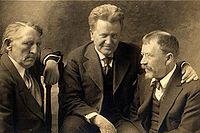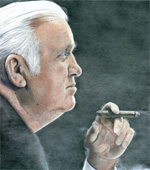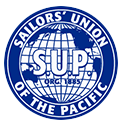The early years
Originally formed as the National Union of Seamen of America in 1892 in Chicago, Illinois, [1] the organization was a federation of independent unions, including the Sailors' Union of the Pacific, the Lake Seamen's Union, the Atlantic Coast Seamen's Union, and the Seamen's and Firemen's Union of the Gulf Coast. [1]
Formed by maritime labor representatives from America's Pacific, Great Lakes and Gulf Coast regions, [1] in 1893, the ISU affiliated with the American Federation of Labor, [2] and took the name International Seamen's Union of America in 1895. [2]
The union existed at a turbulent time in the United States shipping industry. The unions within the ISU faced "continual changeover in the makeup and leadership," [1] and weathered the historical periods of the Great Depression and World War I. Select periods were beneficial, including during World War I when a shipping boom and ISU's membership included more than 115,000 dues-paying members. [1] However, when the boom ended, the ISU's membership shrunk to 50,000. [1]

During its existence, the union did have a major effect on the shipping industry. Perhaps the most significant was the successful lobby for the Seamen's Act of 1915. The act fundamentally changed the life of the American sailor. Among other things, it:
- abolished the practice of imprisonment for seamen who deserted their ship
- reduced the penalties for disobedience
- regulated a seaman's working hours both at sea and in port
- established a minimum quality for ship's food
- regulated the payment of seamen's wages
- required specific levels of safety, particularly the provision of lifeboats
- required a minimum percentage of the seamen aboard a vessel to be qualified Able Seamen
- required a minimum of 75 percent of the seamen aboard a vessel to understand the language spoken by the officers
Another of ISU's successes was the strike of 1919, which resulted in wages that were "an all-time high for deep sea sailors in peace time." [1]
However, ISU had its shortcomings and failures, too. After a round of failed contract negotiations, ISU issued an all-ports strike on May 1, 1921. The strike lasted only two months and failed, with resulting wage cuts of 25 percent. [1] The ISU, as with all AFL unions, was criticized as being too conservative. For example, in 1923 the Industrial Workers of the World publication The Marine Worker referred to the ISU's "pie-cards" (paid officials) as "grafters and pimps." [3] Additionally, the union was weakened by the loss of the Sailors' Union of the Pacific in 1934. Furuseth charged that the SUP was being infiltrated by "radicals" from the IWW, [1] and demanded the SUP cease activities with the Maritime Federation. The SUP refused and the ISU revoked their charter. [4]
The ISU was involved the West Coast longshoremen's strike of 1934. [1] Lasting 83 days, the strike led to the unionization of all West Coast ports of the United States. The San Francisco general strike, along with the 1934 Toledo Auto-Lite Strike led by the American Workers Party and the Minneapolis Teamsters Strike of 1934, were important catalysts for the rise of industrial unionism in the 1930s.
West Coast sailors deserted ships in support of the International Longshoremen's Association longshoremen, leaving more than 50 ships idle in the San Francisco harbor. [1] ISU officials reluctantly supported this strike. In clashes with the police between July 3 and July 5, 1934, three picketers were killed and "scores were injured." [1] During negotiations to end the strike, the sailors received concessions including a three-watch system, pay increases, and better living conditions.
In April 1935 [5] at a conference of maritime unions in Seattle, an umbrella union was established to represent the membership of the ISU as well as maritime officers and longshoremen. Called the Maritime Federation, Harry Lundeberg was named its first president. [5]









